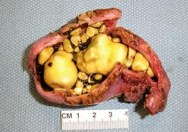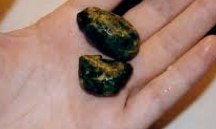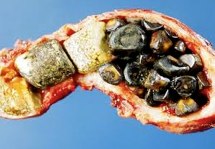Gallstones are hard, pebble-like deposits that form inside the gallbladder. Gallstones may be as small as a grain of sand or as large as a golf ball.
Types of Gallstones
There are two main types of gallstones:
Stones made out of cholesterol. Gallstones made out of cholesterol are by far the most common type. Cholesterol gallstones have nothing to do with the cholesterol levels in the blood.

Stones made from too much bilirubin in the bile. Bile is a liquid made in the liver that helps the body digest fats. Bile is made up of water, cholesterol, bile salts, and other chemicals, such as bilirubin. Such stones are called pigment stones.

Some Gallstones have both components of cholesterol stones and pigment and are known as mixed stones. They form the commonest type of stones that we see in our practice.

Causes
Gallstones are more common in women and people over age 40. Gallstones may also run in families. The cause of gallstones varies.
The following also make you more likely to develop gallstones:
- Failure of the gallbladder to empty bile properly (this is more likely to happen during pregnancy)
- Medical conditions that cause the liver to make too much bilirubin, such as chronic haemolytic anaemia, including sickle cell anaemia
- Liver cirrhosis and biliary tract infections (pigmented stones)
- Diabetes
- Bone marrow or solid organ transplant
- Rapid weight loss, particularly eating a very low-calorie diet
- Receiving nutrition through a vein for a long period of time (intravenous feedings)
Symptoms
Many people with gallstones have never had any symptoms. The gallstones are often discovered when having a routine x-ray, abdominal surgery, or other medical procedure.
However, if a large stone blocks either the cystic duct or common bile duct (called choledocholithiasis); you may have a cramping pain in the middle to right upper abdomen. This is known as biliary colic. The pain goes away if the stone passes into the first part of the small intestine (the duodenum).
Symptoms that may occur include:
- Pain in the right upper or middle upper abdomen:
- May go away and come back
- May be sharp, cramping, or dull
- May spread to the back or below the right shoulder blade
- Occurs within minutes of a meal to within few hours
- Fever
- Yellowing of skin and whites of the eyes (jaundice)
Additional symptoms that may occur with this disease include:
- Abdominal fullness
- Clay-coloured stools
- Nausea and vomiting
It is important to see a doctor if you have symptoms of gallstones. Gallstones are found in many people with gallbladder cancer. The association varies between 3% to 9% based on the geographical location.
Exams and Tests
Tests used to detect gallstones or gallbladder inflammation include based on the severity of disease and any associated complications:
- Abdominal ultrasound
- Abdominal CT scan
- Endoscopic retrograde cholangiopancreatography (ERCP)
- Gallbladder radionuclide scan
- Endoscopic ultrasound
- Magnetic resonance cholangiopancreatography (MRCP)
- Percutaneous transhepatic cholangiogram (PTCA)
Your doctor may order the following blood tests:
- Full Blood Count
- Renal Panel
- PT/PTT
- Liver function tests
- Pancreatic enzymes
Treatment
SURGERY
Some people have gallstones and have never had any symptoms. The gallstones may not be found until an ultrasound is done for another reason. Surgery may not be needed unless symptoms begin.
In general, patients who have symptoms will need surgery either right away, or after a short period of time.
- In the past, open cholecystectomy (gallbladder removal) was the usual procedure for uncomplicated cases. However, this is done less often now.
- A technique called laparoscopic cholecystectomy is most commonly used now. This procedure uses smaller surgical cuts, which allow for a faster recovery. Patients are often sent home from the hospital on the same day as surgery, or the next morning.
- The most recent technique is the Scarless Single Incision Laparoscopic Cholecystectomy. In this technique pain is least as it is through a single small key hole size cut and it is scarless as the incision is made within the belly button. Please see pictures below.
Endoscopic retrograde cholangiopancreatography (ERCP) and a procedure called a sphincterotomy may be done to locate or treat gallstones which have passed into the bile duct causing blockage to the bile duct with jaundice, cholangitis and or pancreatitis.
MEDICATION
Medicines called chenodeoxycholic acids (CDCA) or ursodeoxycholic acid (UDCA, ursodiol) may be given in pill form to dissolve cholesterol gallstones. However, they may take 2 years or longer to work, and the stones may return after treatment ends. Also these drugs work only in the presence of pure cholesterol stones.
Outlook (Prognosis)
Gallstones develop in many people without causing symptoms. Nearly all patients who develop symptoms need surgery for Gallstones.
Possible Complications of Gallstones
Blockage of the cystic duct or common bile duct by gallstones may cause the following problems:
- Acute cholecystitis
- Cholangitis
- Cholecystitis – chronic
- Choledocholithiasis
- Pancreatitis
When to Contact a Medical Professional
Call for an appointment at +65-64790608 if you have:
- Pain in the right upper part of your abdomen
- Yellowing of the skin or whites of the eyes
Prevention
There is no known way to prevent gallstones. If you have gallstone symptoms, eating a low-fat diet and losing weight may help you control symptoms.
Alternative Names
Cholelithiasis; Gallbladder attack; Biliary colic; Gallstone attack; Bile calculus; Biliary calculus.
